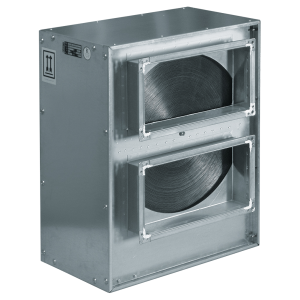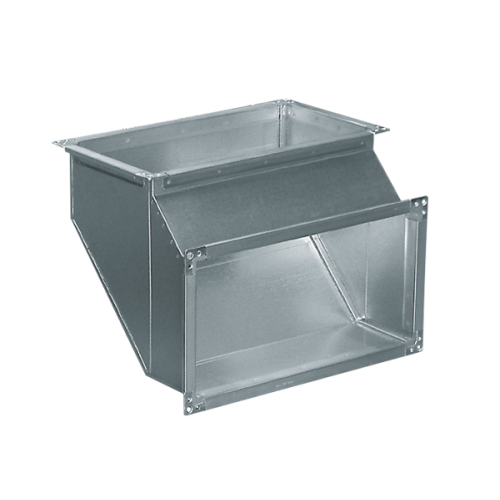Cabinet
The exchanger is made of galvanized steel sheet. Flanges for mounting the inlet and outlet quadrant are provided on the cabinet faces. There is a revision cover on the side of the cabinet for access to the motor or belt replacement.
Regeneration
Rotary heat exchangers comply with the requirements of EC Regulation 1253/2014. The storage mass of the heat exchanger rotor is made up of a cylinder which has a number of small channels formed by winding a flat and \curled aluminium alloy foil. The rotor is housed in ball bearings with a permanent lubrication cartridge. The rotor seal is non-contact, with a clearance between the rotor and the seal that can be defined.
Motor
The rotor is driven by a rubber belt by an asynchronous motor with a short armature worm gearbox. This achieves approximately 12 rpm. For enthalpy exchangers, approx. 20 rpm is achieved. The motor can be equipped with a frequency converter with central and autonomous supply air temperature control. The heat exchangers can be equipped with frost protection provided by a pressure sensor which slows down the rotor speed in case of increased pressure loss on the rotary heat exchanger. However, under normal conditions, no freezing occurs. The direction of rotation is determined by an adhesive arrow.
Speed control
For basic applications, control by switching the RRW HE on and off with a thermostat is sufficient, where a 1×230 V / 50 Hz motor is supplied with the heat exchanger. This control is limited in the case of large heat loads where the ability to transfer large amounts of heat must be limited. Please consult our expert staff for this option. Manufacturer's recommended schematic on request. RRW HE rotary heat exchangers can also be controlled using a frequency converter, where the exchanger is fitted with a 3×230 V/50 Hz motor.
Options
- RRW xxx HE yyy rotary regenerative heat exchanger, where xxx is the size, yyy is the drive type (G1-AC or G3-AC).
Basic design is with 1x230 V/50 Hz motor (ON/OFF control). The alternative is a 3×230 V/50Hz motor (frequency converter control). The motor type must be specified in the order.
- G1-AC drive 40 W 1×230 V / 50 Hz
- G3-AC drive 40 W 3×230 V / 50 Hz
Instructions
When properly designed, the heat exchanger does not require frequent cleaning, the heat exchanger bearings and motor are maintenance free. The sealing brushes, drive belt and electrical inspections should be checked at the intervals specified in the operating code (but at least once a year). In harsh operating conditions with higher dust and humidity, the operating code should be consulted with the heat exchanger manufacturer.
Information
Rotary heat exchangers RRW HE are designed for modular systems with IRB, IRT fans for square duct systems (400×200 to 1000×500 mm) or with reduction for CVB, CVT, CVAB/CVAT-N, CAB fans for circular duct systems (diameter 200 to 500 mm). Rotary regenerative heat exchangers for ILHT or CVTT fans can also be manufactured on special order. The supplied rotary regenerative air-to-air exchangers can be used in central and decentral ventilation systems in industrial and comfort air conditioning. Air flow rates range from 600 to 5350 m3/hr. This range is covered by a range of 4 types. For standard conditions, we recommend a flow velocity in the range of 2 to 4 m/s. The RRW HE rotary heat exchanger allows heat transfer (in the special version also enthalpy transfer, i.e. heat and moisture) from the exhaust air to the supply air. The heat transfer occurs by means of an accumulating rotor mass, where approximately one half is in the extract air stream and the other half is in the supply outside air stream. Under certain conditions, cold transfer may occur. By rotation of the rotor, the heat exchanger heat transfer surface is alternately in the supply and extract air streams and thus heat or cold (or enthalpy) is transferred. These heat exchangers are among the devices with high heat transfer efficiency (enthalpy). Therefore, their use is suitable for all air handling systems with higher air flows. They are very suitable as part of assembled units for supply and extract of ventilation air. This reduces operating costs and thus shortens the return on investment.
- wheel diameter 500, 600, 700, 1000 mm
- air velocity 2 to 4 m/s
- flow rate 600-5350 m3/h
- motor power 40 W
- speed approx. 12 rpm






 Share on Facebook
Share on Facebook Tweet
Tweet Send email
Send email
